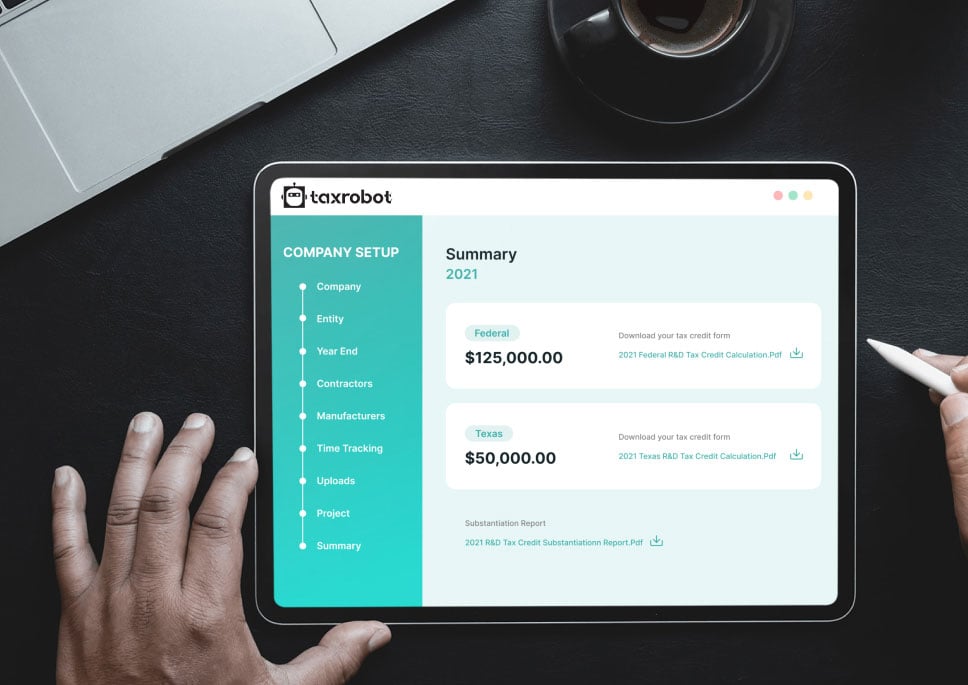Florida R&D Credit
Maximize your State Credits today!
Put the R&D tax credit process on autopilot.
Trusted By:








Florida R&D Credit
Discover your eligibility for Florida R&D tax credits and supercharge your enterprise.
Does My Business Qualify?
Florida places some restrictions on which businesses and activities qualify for the R&D credit. One of the most notable is that only C corporations are eligible. In addition, the expenses you are claiming must be for research conducted in Florida.
In order for a business to claim the Florida R&D tax credit, it must also claim the federal one. There are a lot of similarities between these two credits, so, in general, claiming both at once isn’t too difficult.
This credit is targeted toward certain industries, and only these industries qualify for the credit. The Department of Economic Opportunity certifies these industries, which include:
- Manufacturing
- Information technology
- Cloud information technology
- Materials science
- Nanotechnology industries
- Emerging technologies
- Life sciences
- Homeland security and defense
- Aviation and aerospace
- Marine science
How Much Can You Save?
You’ll first need to figure out your base amount, which is the average of the qualified research expenses (QREs) for the previous four tax years. Your credit is allowed to be 10% of the amount over this base amount. If your business has not existed for at least four taxable years, your maximum credit will be reduced by 25% for each year your business was non-existent.
There is a limit to the amount of funds given out via this tax credit. Only $9 million is allocated for the entire state. Once this cap is reached, credits may be given out on a prorated basis. Because of this, it’s best to apply as soon as possible within the deadline.
The Four-Part Test
In order for your research activities to qualify, they must pass the four-part test. They must:
- Be technological in nature
- Be of a permitted purpose, including improving or developing a new or existing business component
- Eliminate technological uncertainty
- Follow a process of experimentation
Expenses stemming from qualifying research activities may then qualify for the credit.
Claiming the Florida R&D Tax Credit
- Deadline:
The window to claim the state R&D credit is quite small. Applications must be made between March 20 and March 27 for expenses incurred during the previous calendar year. However, it is better to submit them on the earlier side rather than on the later size.
- Unused Credits:
Unused credits can even be pushed to the future. If you have excess credits, you may carry them forward for up to five years.
- Documentation:
Once you have claimed the tax credit, you must maintain proper records substantiating your claims. You’ll need to keep documentation that shows what your research activities were and that you paid for them. This is true for both the state and federal tax credits.
Make Claiming the Florida R&D Credit Easier with TaxRobot
The process of claiming the Florida R&D tax credit involves doing a lot of calculations, looking over a lot of data, and following a series of rather specific rules and regulations. If determining if you qualify for the Florida R&D tax credit sounds like a lot of hassle, it’s time to get help.
- Simplify the process:
TaxRobot can make the process less overwhelming and make sure that you are able to go about it with ease. We also understand the system well and can make sure you are following the process correctly from start to finish.
- Maximize your credit:
We’ll analyze your expenses and situation to make sure you get the largest tax credit you are eligible for.
- Provide audit protection:
We’ll also ensure your documentation is in order and backs up your claims. If you are audited, you can rest easy knowing we’ll field any questions and requests with our audit defense.
Find Out How Much You Could Save On Your Tax Bill
Wondering just how much of a tax savings you could be looking at? Use our calculator to get an estimate and get started with TaxRobot.
Take a sneak peak

- Limited Time Offer
- Simple Onboarding
- Easy to Use
R&D Tax Credits FAQs
The four-part test as outlined in the Internal Revenue Code is used to determine qualified R&D activity.
The Four-Part Test
1). New Or Improved Business Component
Creation of a new product, process, formula, invention, software, or technique; or improving the performance, functionality, quality, or reliability of existing business component.
- Construction of new buildings or renovation of existing buildings
- Invention of a software application
- Manufacturing of a new product or the improvement of the production process for an existing product
- Creation of design documentation
2). Technological In Nature
The activity fundamentally relies on principles of the physical or biological sciences, engineering, or computer science. A taxpayer does not need to obtain information that exceeds, expands or refines the common knowledge of skilled professionals in a particular field.
- Physics (relationship between mass, density and volume; loading as the
result of gravitational attraction) - Engineering (mechanical, electrical, civil, chemical)
- Computer science (theory of computation and design of computational systems)
3). Elimination Of Uncertainty
Uncertainty exists if the information available to the taxpayer does not establish the capability or method for developing or improving the business component, or the appropriate design of the business component.
- The capability of a manufacturer to create a part within the specified tolerances
- The appropriate method of overcoming unsuitable soil conditions during construction
- The appropriate software design to meet quality and volatility requirements
4). Process Of Experimentation
A process designed to evaluate one or more alternatives to achieve a result where the capability or method of achieving that result, or the appropriate design of that result, is uncertain as of the beginning of the taxpayer’s research activities.
- Systematic process of trial and error
- Evaluating alternative means and methods
- Computer modeling or simulation Prototyping Testing
The R&D tax credit is one of the most misunderstood tax incentives available. Considering the myriad of industries and activities that legally qualify for the credit, the term “research and development” is a misnomer. Additionally, the R&D tax credit requires specialized knowledge and technology to identify and calculate the incentive properly.
Companies of various industries are unaware that they are eligible to claim the R&D tax credit. Under the Internal Revenue Code’s definition of R&D, many common activities qualify. You can get tax benefits for industries including software, technology, architecture, engineering, construction, manufacturing, and more.
The R&D tax credit can be claimed for all open tax years. Generally, open tax years include the prior three tax years due to the statute of limitations period. In certain circumstances, the law allows businesses to claim the R&D tax credit for an extended period of time. It is common for companies to amend previous tax years to claim this benefit and reduce the maximum amount of tax liability.
Partnerships and S corporations must file this form to claim the credit. The credit will flow from the Form 6765, to the Schedule K-1, to the Form 3800 on the individual’s tax return. For individuals receiving this credit that have ownership interest in a partnership or S corporation, Form 6765 is not required on the individual return.
Individuals claiming this credit can report the credit directly on Form 3800, General Business Credit if their only source for the credit is a partnership, S corporation, estate, or trust. Otherwise, Form 6765 must be filed with the individual’s tax return (e.g. sole proprietorship).
For tax years prior to 2016, the credit can be used to reduce the taxpayer’s regular tax liability down to the tentative minimum tax. The credit cannot be used to offset alternative minimum tax. Beginning in tax year 2016, eligible small businesses have expanded utilization for the credit. For these eligible small businesses, the regular tax liability can offset alternative minimum tax using the “25/25” rule.
What our customers have to say
I highly recommend TaxRobot to anyone considering an R&D Tax Credit software to complete their analysis.

We decided to switch to TaxRobot… Best decision we’ve ever made. More affordable, and less complicated.

I couldn’t believe how easy it was! In under an hour, we saved enough money to hire a new employee.
